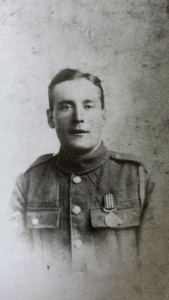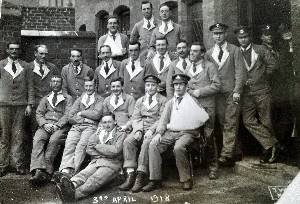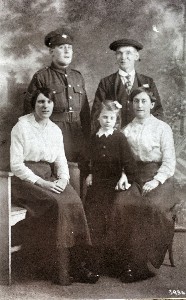
Photo : Ian Richardson
.jpg)
Standing on the right

Wounded, in the back row, right arm in a sling

Family Portrait
His mother was Isabella Richardson, born 1879, daughter of Matthew John Richardson, a Miner.
Isabella Richardson married Sidney Chapman, (born 1879, in Caldwell), 20th May 1899, at Harton Church, South Shields. Robert had a younger sister Isabella C. Dodds, born 1909. All were residing at 14 Robert Street, South Shields.
Robert was employed as a Weighing Assistant at Harton Colliery.
After the outbreak of the war he enlisted at South Shields 14th November 1914, his enrolment application states that his address is now 37 Canterbury Street, South Shields, and his next of kin was his mother, Isabella Chapman, in the Royal Naval Volunteer Reserve, at HMS Satellite, which was located at a School in Laygate Lane, in South Shields. He stated his religion was Church of England and was unmarried. The physical description was stated as 5 feet 4 inches high, dark hair with brown eyes.
He trained at Walmer, and was in the 1st Brigade which consisted then of the Collingwood, Hawke, Benbow and the Drake Battalions. The Royal Naval Division had only been formed a few weeks. The 2nd Brigade were located at Bettysanger, and the 3rd or the Royal Marine Brigade were in camp at Friedown Camp.
Robert's service number was Tyneside Z/1753 and his rank was an Ordinary Seaman. His first service was to join the 3rd Battalion at Crystal Palace 19th January 1915. He then joined the Collingwood Battalion 4th February 1915.
Crystal Palace
In December 1914 the Divisional Train was formed at Crystal Palace. There were plans for a Naval Divisional Cavalry to be called 'Royal Naval Hussars' but plans were dropped and no cavalry was forthcoming. Divisional Artillery was wanted, but the army could not help in view of the needs of the New Army, and Churchill's resources were too small. So the Division was without an artillery until, it was due to arrive on the Western Front in July 1916. The R.N.D. Medical Unit began training at the Palace on the 3rd December 1914.
He was on the Nominal Roll of the Collingwood Battalion at this time but was then transferred to the Anson Battalion 'A' Company on the 8th of June 1915. Robert was also promoted to an A.B. (Able Seaman) on the 10th May 1915.
Voyage to the Dardanelles.
On the 1st February 1915 the Plymouth and Chatham Marine Battalions together with their staff left Blandford for the Mediterranean Sea. The R.N.D. fleet left Avonmouth on the 28th/29th February 1915. Put in at Valletta, Malta at about 3 p.m. 8th March 1915, leaving the next day at 11.30 a.m. In the evening of the 11th March the fleet dropped anchor at Mudros Bay at the Island of Lemnos. 17th March orders were given to sail and ships took part in a diversion demonstration to draw the attention of the Turks away from the attempt by British and French ships to force the Dardanelles by naval power. 24th March left Mudros Bay agan, and made for Port Said, Egypt and disembarked on the 28th March. At 7 a.m. 1st April 1915 two half battalions from each of the 1st and 2nd Brigades (Drake, Nelson, Howe and Anson) left for Kantara. It was reported that and attack was to be made by the Turks on the canal defences at Kantara. Things came to a head when on the 7th all troops in Alexandria were ordered to stand by. But the attack was just a reconnaissance by a sixty strong mounted patrol. It was beaten off without loss, so at 2 p.m. they were stood down. 5th April Anson Battalion was ordered to Alexandria to act as beach parties for the 29th Division during the main Gallipoli landings. 10th April fleet put again to sea and by the 14th April fleet arrived once again at the island of Lemnos. However the anchorage was full and it was ordered to the island of Skyros. On the evening of the 17th April the fleet pulled into Trebuki Bay and stayed there until 6 a.m. 24th April when the fleet made for Gallipoli. The demonstration by the Royal Naval Division took place in the Gulf of Saros. Landings were to be made at Helles, Kum Kale and Gaba Tepe. Unfortunately, due to navigational errors, the landings scheduled to take place at Gaba Tepe actually occurred further up the coast in an area which later became known as Anzac Cove.
Islands
The 1st (R.Naval) Brigade policed the islands of Tenedos, Imbros and Mudros.
Tenedos had one company of the Hood Battalion. Imbros, the Hawke and Drake Battalions with the HQ. Mudros, had the remainder of the 1st Brigade.
The War diary entry for the 14th May 1916, reads:- "2nd Bde. Head Qrs. 1st RM Bn. 2 Coys "Anson" Bn. 1 Coy "Howe" Bn. 1 officer & 2 OR Pay Dept. & 2 Chaplains embarked in HMT ARAGON. Arrived in Marseilles on the 19th May 1916."
Voyage to France
The Division left for France in May 1916, landing at Marseilles.
Robert arrived in France on the 27th June 1916. France.
By July 1916, the R.N.D. was under Army Control and the Royal Naval Division became the 63rd (R.N.) Division. * Three Brigades were formed with army battalions become the 190th Brigade. They were to take part in the Battle of the Ancre in November 1916, the last battle of the Somme Campaign. In which they captured the village of Beaucourt, taking many hundreds of prisoners. After an attack on the Puisieux and River Trenches they later helped chase the Germans back to their Hindenburg Line, in the terrible winter of 16/17. By April 17th they had captured the village of Gavrelle, as being part of the Arras offensive. it was in October 1917 in the mud of Passchendaele offensive that they were to fight again, having learned new tactics. In December 1917 they had moved to the area of Welsh Ridge, beating off German attacks.
On the 12th December Robert was granted leave back to the UK, and returned back to his unit on the 23rd December in time for Christmas. He was promoted to an Acting Leading Seaman on the 1st January 1917.
Robert then was promoted to acting Petty Officer on the 30th June 1917, then he was severely reprimanded on the 14th September 1917, for Neglect of Duty and "for telling a lie."
Robert's Military Medal arrived from the Woolwich Medal Office 30th July 1917.
He then had leave granted to the UK, from the 21st January to the 4th February and was given a Railway Warrant.
Robert was wounded by a gunshot wound in the wrist on his right arm on the 25th March 1918.
Robert was after recovering at the 2nd Eastern General Hospital at Brighton. [See above photo].
After recovery he reverts back to a Leading Seaman, and is given a Furlough from the 24th April to the 3rd May 1918. Then is admitted to the 3rd Canadian Stationery Hospital at Doullens. He was then invalided back to the UK, Robert was presented with his Military Medal at Aldershot on the 18th June 1918.
Whilst at Aldershot he qualified Grade 2 at a Lewis Gun Course, but not recommended as an Instructor. He was demobilised at North Camp, Ripon on the 28th December 1918. Date of Discharge was finally settled on the 25th January 1919.
Robert was awarded the Military Medal (London Gazette 4th Supplement, dated 9th July 1917, page 6835).
He married 6th August 1918 at the registry office Hilda Dodsworth.
Prior to World War 2, he was a crane driver, he then enlisted in the Home Guard 11th May 1942. Robert gave his residence address as 25 Ravensworth Road, South Shields, he was given the rank of Lance Bombardier but at his own request reverted back to a private. Robert was in the 101st Anti-Aircraft Battery from the 13th October 1942.
**Home Guard units in coastal towns and villages were often attached to Regular Army units manning coastal gun batteries and, from April 1942, many Home Guard Anti-Aircraft units were formed. By 1944 these units had taken over a large number of anti-aircraft batteries, including the "Heavy" units, thus releasing regular troops for invasion duties. There were two Home Guard anti-aircraft units based in Gateshead -the "71 Durham Home Guard Heavy Anti-Aircraft Battery" and the "110 (101 County of Durham Home Guard) Anti-Aircraft Rocket Battery". The identification codes worn by the members on their sleeves were "DHM/71" or "DHM/101". (All counties numbered their Home Guard H.A.A. Batteries from 71 and their Rocket Batteries from 101 - the "110" prefix is a Royal Artillery serial number). The Rocket unit had its headquarters at the Old Masonic Hall, Half Moon Lane, Gateshead but manned Rockcliffe Battery at South Shields.
Robert was discharged on the 31st December 1945 when the Home Guard was disbanded. On his Form of Enrolment, (W3066) he gave his date of birth as the 15th January 1898. So he lied about his age in WW1 to enlist".
Robert was a safety officer for the Westoe Colliery, he died on the 14th October 1973.
* Source:-"The above is taken from Issue No.1 June 1997 of the R.N.D. magazine published by Mr. Len Sellers."
** Source:-"Rowlands Gill and the North East"

